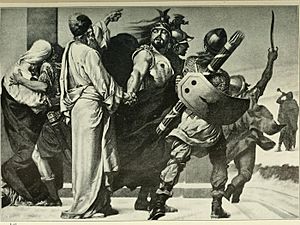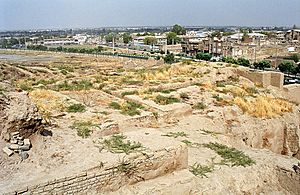Deioces facts for kids
Quick facts for kids Deioces |
|
|---|---|
| The First Legislator (Median: Paradat) |
|

Deioces commands the Medes to set forth on their course of conquest. After a painting by Louis Boulanger (1806-1867).
|
|
| King of the Medes | |
| Reign | 727 - 675 BC |
| Successor | Phraortes |
| Died | 675 BC |
| Religion | Old Iranian religion |
Deioces was the first king and a priest of the Median Empire. His name comes from an old Iranian word, Dahyu-ka, which means "the lands." Different historical records spell his name in various ways. For example, the Greek historian Herodotus wrote his name as Dēiokēs.
Historians are not completely sure about the exact years Deioces ruled. It was likely during the first half of the 7th century BC. Herodotus says that Deioces was king for 53 years.
According to Herodotus, Deioces was the first Median king to become independent from the Assyrians. He had a big idea to unite the Medes under one government. At a time when the Medes had no strong ruler, he started bringing justice to his own village. He became known as a fair judge.
Soon, people from other villages also came to him for help. But Deioces eventually said that the work was too much for him. He announced he would stop being a judge. After he stopped, crime and disorder grew worse. So, the Medians gathered and chose him as their king to bring peace back.
Contents
Becoming King of the Medes
Deioces' first actions after becoming king were important. He chose guards to protect himself. He also decided to build a new capital city.
The city he chose was called Hagmatāna in old Persian. Today, we know it as Ecbatana in Greek, which is believed to be Hamadan in modern Iran. The name Ecbatana means "the gathering place" or "a city for everyone." This shows how different Median groups came together to form the city.
Around the late 8th century BC, Deioces built a strong castle on a hill in Ecbatana. This castle was the center for all military, government, and money matters.
Early Challenges
In 715 BC, Sargon II, the king of Assyria, found out that Deioces had become friends with Rusa I, the king of Urartu. Sargon II began to watch Deioces closely. During a war with another group called the Mannaeans, Sargon II entered the Median lands. He said he wanted to end the "disorder" there.
Sargon II eventually captured Deioces. He sent Deioces and his family far away to Hama, a city in what is now Syria.
Deioces in Ancient Stories
Some experts who study Iran believe Deioces might be the same person as Hushang from the famous Persian epic, the Shahnameh. This is because of the things Herodotus said about Deioces. They think the title Paradat or Pishdadian means "the first lawmaker."
In ancient religious stories, Hushang is seen as the first person to start kingship in Iran. There are a few things that are similar between Deioces and Hushang:
- Village Leader: Herodotus said Deioces was a village leader. His name might even mean "farmer." Hushang, in other texts, made improvements in farming.
- First King and Lawmaker: Both Deioces and Hushang are seen as the first lawmakers and kings. Hushang was given titles like Paradat or Pishdad because of this.
- Building Cities: Deioces and Hushang both helped develop cities and a settled way of life. Hushang's name, Hushang, is linked to building and housing.
The Median Kingdom Begins
In ancient times, the Medes lived in an area surrounded by mountains and deserts. For a long time, from the 9th to the 7th century BC, the Median tribes were not united. Assyrian kings often attacked the Medes. They always found many small "local kings" instead of one strong ruler over all the Median lands.
After the Assyrian king Sargon II died in 705 BC, the Assyrians focused on other areas. This gave the Medians a chance to unite. The constant fear of Assyrian attacks also pushed the Median leaders to form a union. Deioces' followers were key to this movement.
According to Herodotus, Deioces was the one who thought of creating a single Median government. Before him, the Medians lived in separate villages or small towns. Deioces started by bringing justice to his own village. He became known as a fair judge. People from other villages then came to him for help.
Eventually, Deioces said the work was too much. He announced he would stop. After he resigned, theft and chaos increased. So, the Medians gathered and chose him as their king to solve their problems. Assyrian records first mention an independent Median kingdom in 673 BC.
Deioces likely copied some ideas from the Assyrians. Herodotus says that Deioces stayed in his palace. People could not see him directly. Messages and requests were sent only through messengers. This was done to create a sense of awe and respect for the king. Also, it was forbidden to laugh or spit in the king's presence.
Deioces also created a group called "The King's Eyes and Ears." These were people who spied for the king. This system continued even into the later Achaemenid Empire.
Ecbatana's Design
After becoming king, Deioces' first step was to choose guards and build a capital city. He chose a place called Hagmatāna in Old Persian, known as Ecbatana in Greek. Today, it is believed to be the city of Hamadan. Ecbatana means "the gathering place" and showed how the different Median groups came together.
In the late 8th century BC, Deioces built a strong castle on a hill in Ecbatana. This castle was where all the important military, government, and financial decisions were made.
Herodotus described the royal complex as having seven concentric walls. Each inner wall was taller than the one outside it. Each of the seven walls was painted a different color:
- The first (outermost) wall was white.
- The second wall was black.
- The third was bright red.
- The fourth was blue.
- The fifth was a lighter red.
- The sixth wall was copper-colored.
- The seventh and innermost wall was gold.
This coloring was a symbol of the seven planets in Babylon. It seems Ecbatana copied this idea from Babylon. The king's palace and his treasures were inside the very last wall.
Some historians and archaeologists believe that the hill in Hamadan today, known as Ecbatana Hill, is the actual site of the ancient city.
Who Came After Deioces?
After Deioces, his son, Phraortes, became king. Phraortes ruled for 22 years. During his time, he conquered Persia and fought with other groups on the Iranian Plateau. He also attacked Assyria. However, the Medians were defeated in these attacks, and Phraortes was killed in battle.
See also
 In Spanish: Deyoces para niños
In Spanish: Deyoces para niños



